Experimental Investigation of Ice Loads on Structures during Quasi-Static Compression Tests
Abstract
:1. Introduction
2. Quasi-Static Compression Experiments on Ice–Structure Interaction
2.1. Uniaxial Compression and Three-Point Bending Tests of Ice Specimens
2.2. The Experimental Setup and Its Implementation
2.3. Experimental Results
2.3.1. Analysis of Ice Failure Mode
2.3.2. Structural Deformation
2.3.3. Load–Displacement Data during the Test Process
3. Static Ice Load Calculation Method
3.1. The Method of Predicting Static Ice Loads Based on Linear Formulas
3.2. Exponential Formula-Based Predictive Method for Static Ice Loads
4. Comparison of Ice Load Magnitudes from Experiments and Empirical Formulas
5. Discussion
5.1. Comparative Analysis of Different Empirical Formulas
5.1.1. Identifying the Factors for Determining Correction Coefficient
5.1.2. Ice Load Magnitude and Contact Surface Shape Characteristics
5.2. Modification of the Korzhavin Formula Based on Experimental Outcomes
6. Conclusions
- (1)
- Various standards and empirical formulas exist for static ice load prediction, which can be classified into two main types based on their formulation: linear and exponential. In practical applications, the results obtained from different empirical formulas often exhibit significant variation due to variations in engineering contexts, ice conditions, etc.
- (2)
- Quasi-static compression tests of ice–structure interaction were conducted. The stiffened panel did not undergo any noticeable or easily observable plastic deformation. In all the tests studied in this paper, the ice block consistently exhibits significant cracking at the middle stiffener of the panel, and the maximum load values demonstrate a nonlinear positive correlation with the contact area.
- (3)
- A comprehensive discourse on the determination of various parameters was undertaken, encompassing aspects such as the correction coefficient, characteristics of the contact surface shape, and the structural shape coefficient. The Korzhavin formula is shown to exhibit enhanced applicability and precision in comparison to other empirical formulas. Therefore, a compression coefficient deduced from experimental results is presented, which also substantiates the empirical formula’s rationality and efficacy.
Author Contributions
Funding
Institutional Review Board Statement
Informed Consent Statement
Data Availability Statement
Conflicts of Interest
References
- Korzhavin, K.N. Action of Ice on Engineering Structures; Defense Technical Information Center: Fort Belvoir, VA, USA, 1962.
- Croasdale, K.R.; Morgenstern, N.R.; Nuttall, J.B. Indentation Tests to Investigate Ice Pressures on Vertical Piers. J. Glaciol. 1977, 19, 301–312. [Google Scholar] [CrossRef]
- Michel, B.; Toussaint, N. Mechanisms and Theory of Indentation of Ice Plates. J. Glaciol. 1977, 19, 285–300. [Google Scholar] [CrossRef]
- Frederking, R.; Timco, G.; Reid, S. Sea Ice Floe Impact Experiments; National Research Council of Canada: Quebec, QC, Canada, 1999. [Google Scholar] [CrossRef]
- Veritas, B. NI565 Ice Characteristics and Ice/Structure Interactions. Guidance Note NI, 2010. Available online: https://marine-offshore.bureauveritas.com/ni565-ice-characteristics-and-icestructure-interactions (accessed on 28 March 2024).
- ISO19906:2019(E); Petroleum and Natural Gas Industries—Arctic Offshore Structures. ISO: Geneva, Switzerland, 2019.
- Masterson, D.M.; Kouzmitchev, K.; deWaal, J. Russian SNiP 2.06.04-82 and Western Global Ice Pressures–A Comparison. In Proceedings of the 17th International Conference on Port and Ocean Engineering under Arctic Conditions, Trondheim, Norway, 16–19 June 2003. [Google Scholar]
- Masterson, D.M.; Susan Tibbo, J. Comparison of Ice Load Calculations Using ISO 19906, CSA, API and SNiP. In Proceedings of the 21st International Conference on Port and Ocean Engineering under Arctic Conditions (POAC’11), Montréal, QC, Canada, 10–14 July 2011; Volume 2. [Google Scholar]
- Timco, G.; Croasdale, K. How Well Can We Predict Ice Loads? IAHR 2006, 1, 167–174. [Google Scholar]
- Kellner, L.; Herrnring, H.; Ring, M. Review of Ice Load Standards and Comparison with Measurements. In Proceedings of the International Conference on Offshore Mechanics and Arctic Engineering–OMAE, American Society of Mechanical Engineers, Trondheim, Norway, 25–30 June 2017; Volume 57762, p. V008T07A028. [Google Scholar]
- Gravesen, H.; Sørensen, S.L.; Vølund, P.; Barker, A.; Timco, G. Ice Loading on Danish Wind Turbines: Part 2. Analyses of Dynamic Model Test Results. Cold Reg. Sci. Technol. 2005, 41, 25–47. [Google Scholar] [CrossRef]
- Zhou, L.; Riska, K.; von Bock und Polach, R.; Moan, T.; Su, B. Experiments on Level Ice Loading on an Icebreaking Tanker with Different Ice Drift Angles. Cold Reg. Sci. Technol. 2013, 85, 79–93. [Google Scholar] [CrossRef]
- Zong, Z.; Yang, B.Y.; Sun, Z.; Zhang, G.Y. Experimental Study of Ship Resistance in Artificial Ice Floes. Cold Reg. Sci. Technol. 2020, 176, 103102. [Google Scholar] [CrossRef]
- Su, B. Numerical Predictions of Global and Local Ice Loads on Ships. Ph.D. Thesis, Norwegian University of Science and Technology, Trondheim, Norway, 2011. [Google Scholar]
- Liu, Z.; Amdahl, J.; Løset, S. Numerical Simulation of Collisions between Ships and Icebergs. In Proceedings of the International Conference on Port and Ocean Engineering under Arctic Conditions, POAC, Lulea, Sweden, 9–12 June 2009; Volume 1. [Google Scholar]
- Yu, T.; Liu, K.; Wang, G.; Liu, J.; Wang, Z. A Tri-Axial Ice Model for Simulating Ice-Stiffened Panel Impact: Experiments and Numerical Modeling. Mar. Struct. 2023, 88, 103358. [Google Scholar] [CrossRef]
- Truong, D.D.; Jang, B.-S. Estimation of Ice Loads on Offshore Structures Using Simulations of Level Ice-Structure Collisions with an Influence Coefficient Method. Appl. Ocean Res. 2022, 125, 103235. [Google Scholar] [CrossRef]
- Xu, Y.; Wu, J.; Li, P.; Kujala, P.; Hu, Z.; Chen, G. Investigation of the Fracture Mechanism of Level Ice with Extended Finite Element Method. Ocean Eng. 2022, 260, 112048. [Google Scholar] [CrossRef]
- Zheng, X.; Tian, Z.; Xie, Z.; Zhang, N. Numerical Study of the Ice Breaking Resistance of the Icebreaker in the Yellow River Through Smoothed-Particle Hydrodynamics. J. Mar. Sci. Appl. 2022, 21, 1–14. [Google Scholar] [CrossRef]
- Schwarz, J.; Frederking, R.; Gavrillo, V.; Petrov, I.G.; Hirayama, K.I.; Mellor, M.; Tryde, P.; Vaudrey, K.D. Standardized Testing Methods for Measuring Mechanical Properties of Ice. Cold Reg. Sci. Technol. 1981, 4, 245–253. [Google Scholar] [CrossRef]
- Timco, G.W.; Weeks, W.F. A Review of the Engineering Properties of Sea Ice. Cold Reg. Sci. Technol. 2010, 60, 107–129. [Google Scholar] [CrossRef]
- Wang, G.; Zhang, D.; Xu, N.; Wang, S.; Yu, D.; Yue, Q. The Research of Extreme Ice Load for Flexible Vertical Structures in Sub-Arctic Environment. Ekoloji 2018, 27, 2033. [Google Scholar]
- Rødtang, E.; Alfredsen, K.; Høyland, K.; Lia, L. Review of River Ice Force Calculation Methods. Cold Reg. Sci. Technol. 2023, 209, 103809. [Google Scholar] [CrossRef]
- Neill, C.R. Dynamic ice forces on piers and piles. An assessment of design guidelines in the light of recent research. Can. J. Civil. Eng. 1976, 3, 305–341. [Google Scholar] [CrossRef]
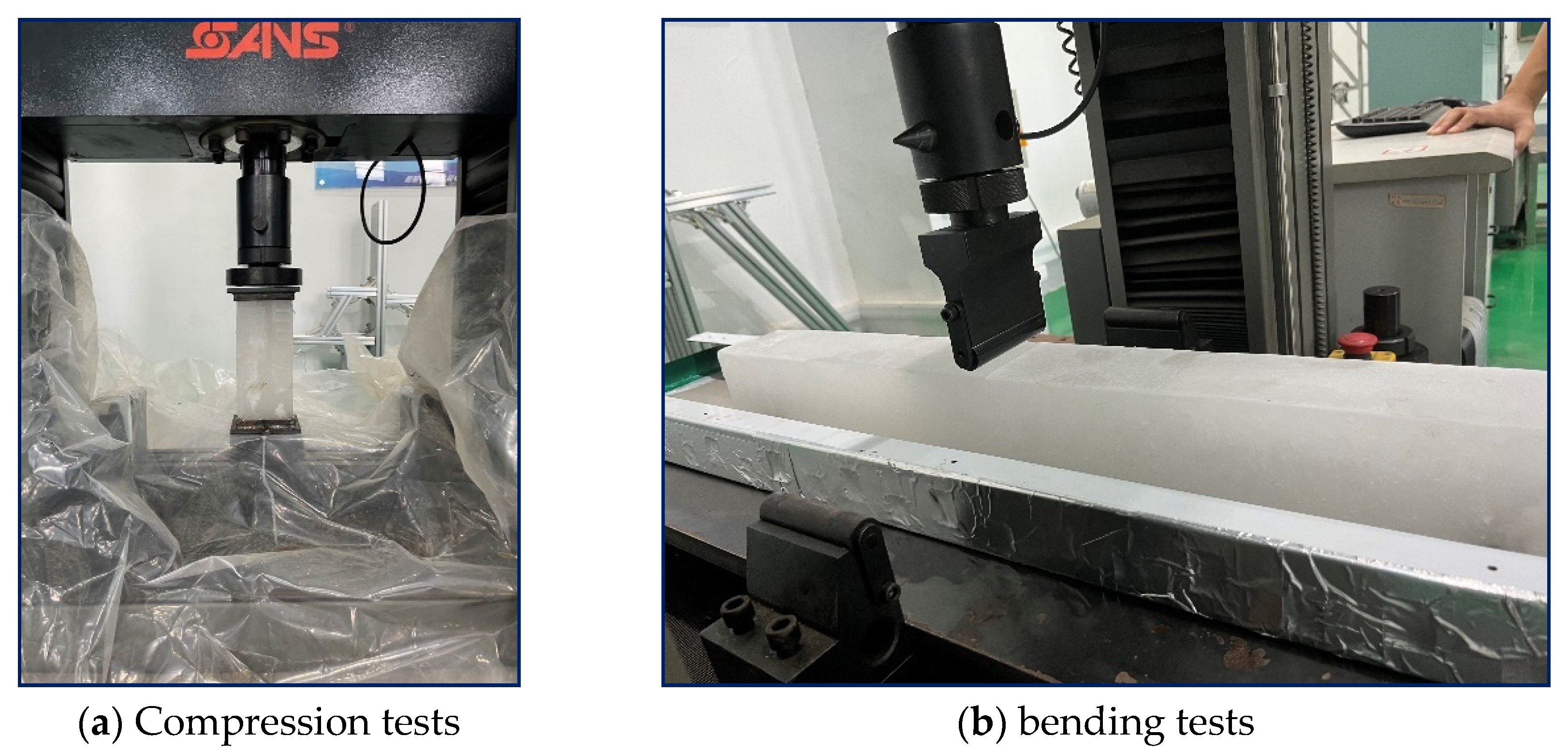



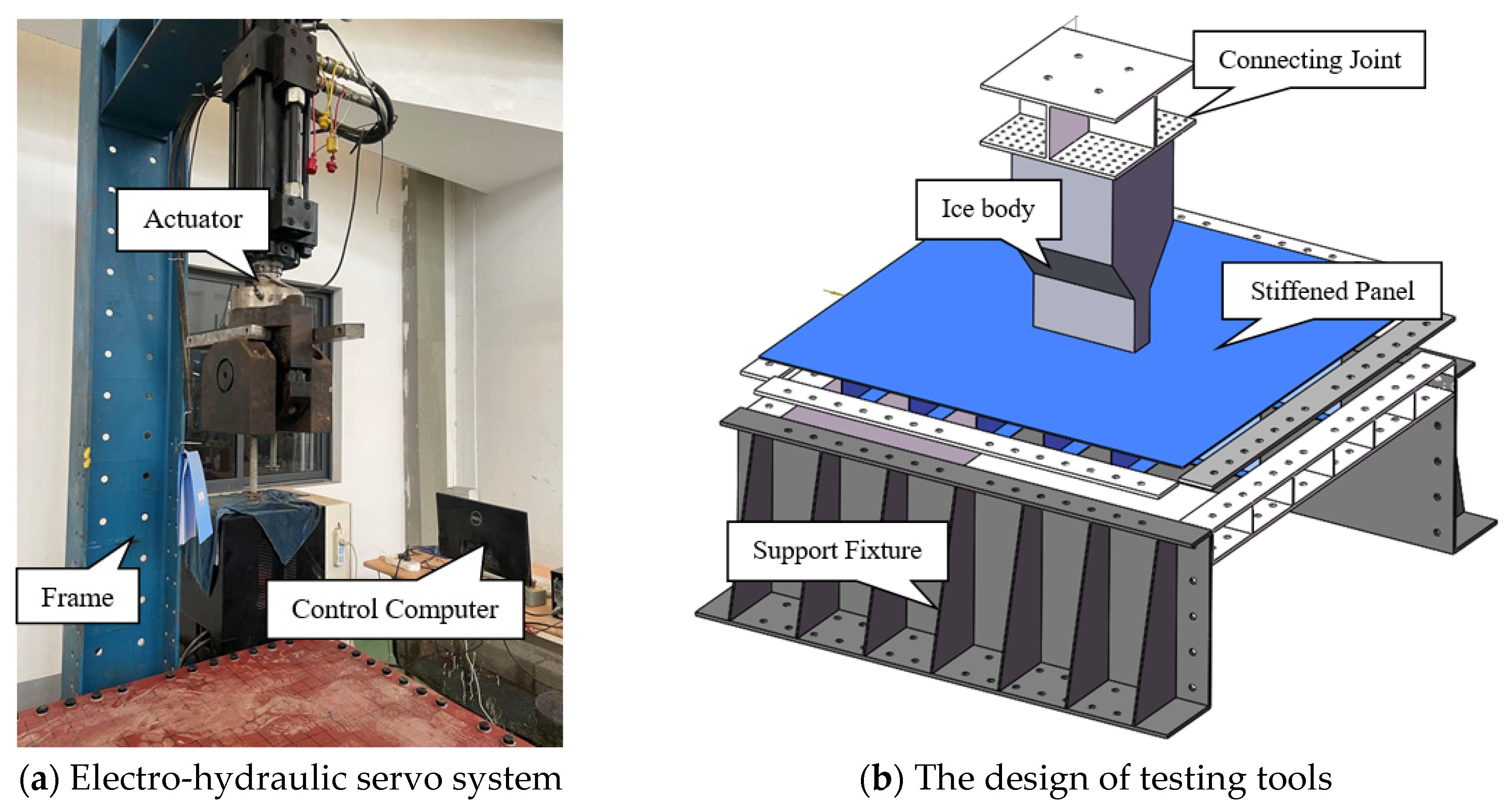
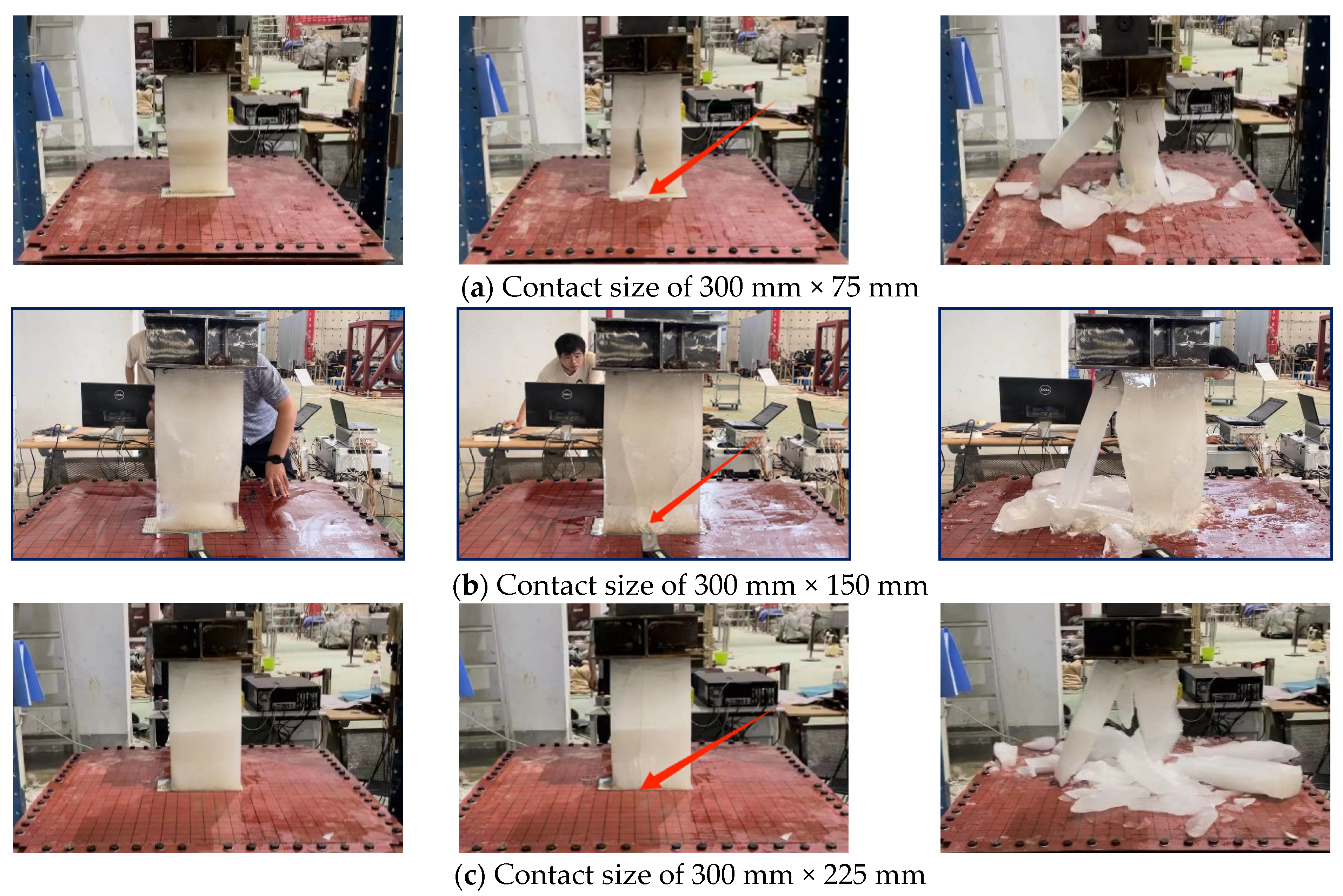
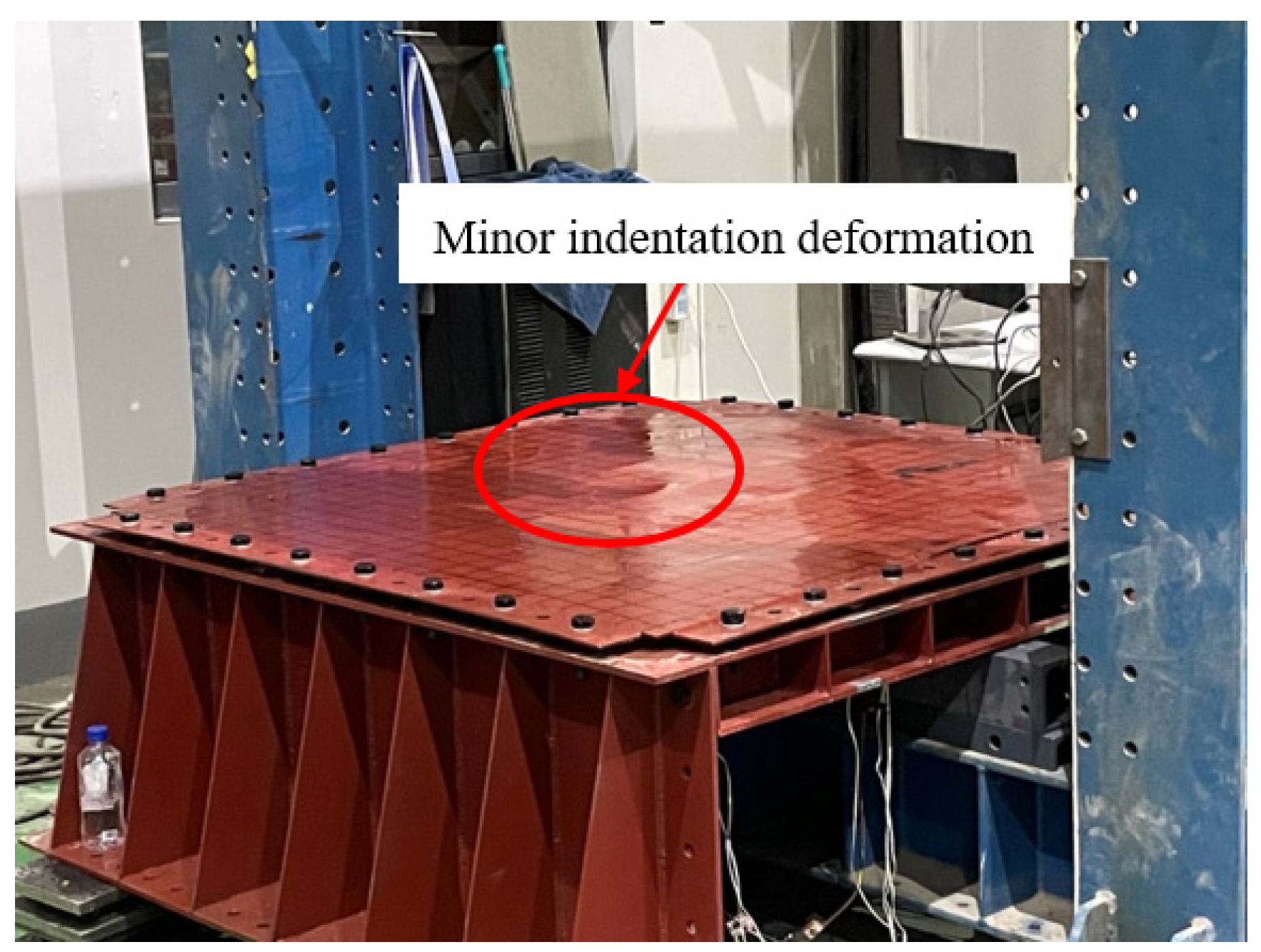

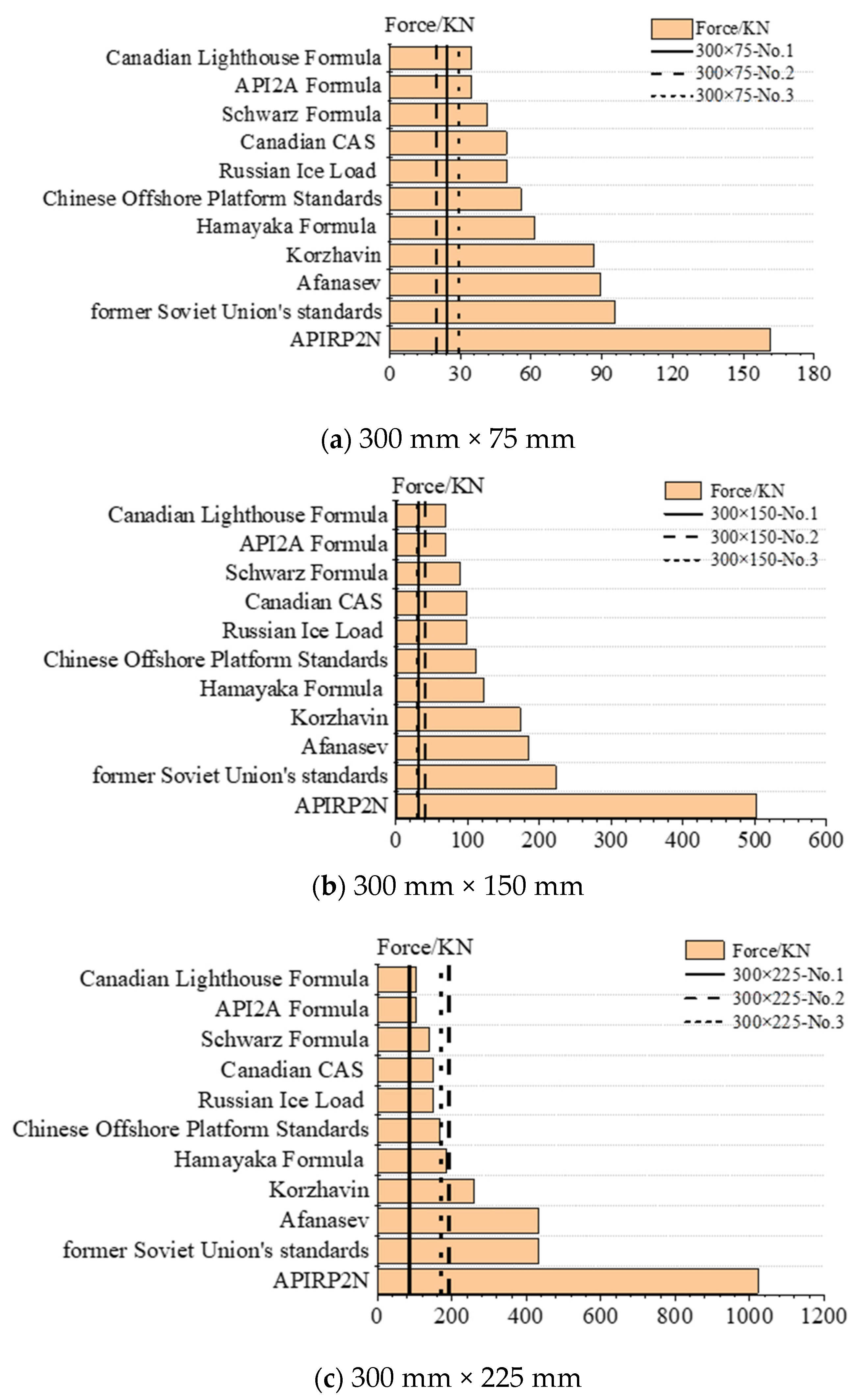
| Test Number | Ambient Temperature (°C) | Compressive Strength (MPa) | Mean Compressive Strength (MPa) |
|---|---|---|---|
| No.1 | 25 | 1.86 | 2.20 |
| No.2 | 25 | 2.37 | |
| No.3 | 25 | 1.65 | |
| No.4 | 25 | 3.19 | |
| No.5 | 25 | 2.35 | |
| No.6 | 25 | 1.77 |
| Test Number | Ambient Temperature (°C) | Bending Strength (MPa) | Mean Bending Strength (MPa) |
|---|---|---|---|
| No.1 | 25 | 1.59 | 1.66 |
| No.2 | 25 | 1.93 | |
| No.3 | 25 | 1.96 | |
| No.4 | 25 | 1.69 | |
| No.5 | 25 | 1.71 | |
| No.6 | 25 | 1.02 |
| Case Number | First Peak Load (KN) | First Peak Pressure (MKN) | Maximum Load (KN) | Maximum Load Pressure (MKN) |
|---|---|---|---|---|
| 300 mm × 75 mm-NO.1 | 20.72 | 0.92 | 45.79 | 2.06 |
| 300 mm × 75 mm-NO.2 | 18.83 | 0.84 | 29.63 | 1.40 |
| 300 mm × 75 mm-NO.3 | 29.04 | 1.20 | 29.04 | 2.70 |
| 300 mm × 150 mm-NO.1 | 31.68 | 0.70 | 45.20 | 1.00 |
| 300 mm × 150 mm-NO.2 | 40.97 | 0.91 | 46.46 | 1.03 |
| 300 mm × 150 mm-NO.3 | 30.17 | 0.67 | 30.94 | 0.69 |
| 300 mm × 225 mm-NO.1 | 84.54 | 1.25 | 84.54 | - |
| 300 mm × 225 mm-NO.2 | 190.45 | 2.85 | 190.45 | - |
| 300 mm × 225 mm-NO.3 | 171.60 | 2.54 | 171.60 | - |
| Name | Expression | Meaning of the Parameters | Background |
|---|---|---|---|
| Korzhavin | : local compression coefficient; : relative velocity; : reference velocity; : structural shape coefficient; : contact condition coefficient; : ice thickness. | Based on a large number of experimental data and theoretical analysis of Siberian rivers. | |
| Afanasev (1971) | : local compression coefficient; : structural shape coefficient. | Based on Korzhavin, further research is carried out, and the calculation method under different D/H ratios is obtained. | |
| Lu | For vertical piers: For inclined piers, horizontal force: Vertical force: | : regional coefficient; : comprehensive correction coefficient; : ice’s flexural strength; : the angle of inclination of the ice-breaking edge of the bridge pier. | This paper is based on a large number of experiments on the ice pressure on the No.3 pier of the Songhua River Bridge caused by the ice flow in the Hal Glacier section of the Songhua River in China. |
| Former Soviet Union’s standards | : local compression coefficient. | Based on the Arctic coastline scene of the former Soviet Union, the ice pressure acting on the vertical pier is analyzed. | |
| Russian Ice Load Regulations | : structural ice-facing surface shape coefficient; : ice thickness. | The ice surface of the bridge pier is vertical, and the ice load on the bridge pier is applied. | |
| American API2A Formula | : coefficient dependent on the structural shape, ice velocity, and other factors. | For the flowing ice force acting on a single column, the larger the ratio of pile diameter to ice thickness, the smaller the coefficient ‘c’. | |
| American APIRP2N Formula | : local compression coefficient; : contact coefficient. | Based on the ice flow force on a single column in the Cook Bay of Alaska, USA. | |
| Canadian CAS Formula (1974) | : effective ice pressure. | Based on the unique ice environment and cold temperate climate in Canada, the force of flowing ice on buildings is proposed. | |
| Canadian Standards for Bridge Piers | : inclination coefficient of bridge pier fore-edges. | Based on different inclination angles of the leading edge of the pier, there are different inclination coefficients. | |
| Canadian Lighthouse Formula (1975) | : comprehensive correction coefficient. | Ensure that the Canadian offshore lighthouse structure can withstand the ice load that may be suffered under extreme conditions. | |
| Chinese Offshore Platform Standards | : local compression coefficient; : contact coefficient; : ice’s compressive strength. | Under the action of wind and current, the ice load of a large area of the ice sheet on the vertically isolated pile. |
| Name | Expression | Notes | Background |
|---|---|---|---|
| Schwarz Formula | : unit in KN; : unit in ; : unit in . | A large number of experimental and theoretical studies have been conducted in the Baltic Sea, North Sea, and North Atlantic, and a multi-coefficient formula is proposed. | |
| Hamayaka Formula | : correction coefficient. For circular cross-sections, it takes 5.0; for rectangular cross-sections, it takes 6.8. | Based on the ice situation in the Beibu Gulf of Japan. |
| 2α | 45° | 60° | 75° | 90° | 120° | 180° |
|---|---|---|---|---|---|---|
| m | 0.6 | 0.65 | 0.69 | 0.73 | 0.81 | 1.0 |
| Inclination Angle | Inclination Coefficient Cn | The Ratio of Vertical to Horizontal Forces FV/FH | |
|---|---|---|---|
| α | β | ||
| 0 | 90 | 1.00 | 0 |
| 15 | 75 | 0.75 | 0.11 |
| 20 | 70 | 0.75 | 0.20 |
| 25 | 65 | 0.75 | 0.29 |
| 30 | 60 | 0.75 | 0.39 |
| 35 | 55 | 0.50 | 0.50 |
| 40 | 50 | 0.50 | 0.61 |
| 45 | 45 | 0.50 | 0.74 |
| Case Number | First Peak Load (KN) | Local Compression Coefficient Value | Average Compression Coefficient | COV (Coefficient of Variation) | Empirical Formula-Derived Ice Loads (KN) | Relative Error (%) |
|---|---|---|---|---|---|---|
| 300 mm × 75 mm-NO.1 | 20.72 | 0.71 | 0.70 | 0.7/2.5 = 0.28 | 24.15 | 1.79 |
| 300 mm × 75 mm-NO.2 | 18.83 | 0.54 | 28.25 | |||
| 300 mm × 75 mm-NO.3 | 29.04 | 0.84 | 16.84 | |||
| 300 mm × 150 mm-NO.1 | 31.68 | 0.42 | 0.49 | 0.49/2.5 = 0.196 | 33.90 | 7.01 |
| 300 mm × 150 mm-NO.2 | 40.97 | 0.46 | 17.26 | |||
| 300 mm × 150 mm-NO.3 | 30.17 | 0.59 | 12.36 | |||
| 300 mm × 225 mm-NO.1 | 84.54 | 0.61 | 1.07 | 1.07/2.5 = 0.428 | 111.23 | 31.57 |
| 300 mm × 225 mm-NO.2 | 190.45 | 1.37 | 41.59 | |||
| 300 mm × 225 mm-NO.3 | 171.60 | 1.24 | 35.18 |
Disclaimer/Publisher’s Note: The statements, opinions and data contained in all publications are solely those of the individual author(s) and contributor(s) and not of MDPI and/or the editor(s). MDPI and/or the editor(s) disclaim responsibility for any injury to people or property resulting from any ideas, methods, instructions or products referred to in the content. |
© 2024 by the authors. Licensee MDPI, Basel, Switzerland. This article is an open access article distributed under the terms and conditions of the Creative Commons Attribution (CC BY) license (https://creativecommons.org/licenses/by/4.0/).
Share and Cite
Xia, J.; Yu, T.; Liu, K.; Xiang, J.; Zhao, N.; Liu, J. Experimental Investigation of Ice Loads on Structures during Quasi-Static Compression Tests. J. Mar. Sci. Eng. 2024, 12, 924. https://doi.org/10.3390/jmse12060924
Xia J, Yu T, Liu K, Xiang J, Zhao N, Liu J. Experimental Investigation of Ice Loads on Structures during Quasi-Static Compression Tests. Journal of Marine Science and Engineering. 2024; 12(6):924. https://doi.org/10.3390/jmse12060924
Chicago/Turabian StyleXia, Jinsong, Tongqiang Yu, Kun Liu, Junji Xiang, Nan Zhao, and Junjie Liu. 2024. "Experimental Investigation of Ice Loads on Structures during Quasi-Static Compression Tests" Journal of Marine Science and Engineering 12, no. 6: 924. https://doi.org/10.3390/jmse12060924




